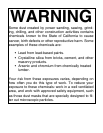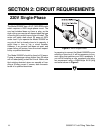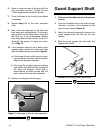
G5959Z 12" Left-Tilting Table Saw -7-
Common Definitions, Terms and Phrases
The following is a list of common definitions, terms and phrases used throughout this manual as they relate
to this table saw and woodworking in general. It is important that you read and become familiar with them
before assembling, adjusting or operating this machine. Your safety is VERY important to us at Grizzly!
Arbor: Metal shaft extending from the drive
mechanism. The cutting blade attaches to the
arbor.
Bevel Edge Cut: Tilting the saw arbor and blade
to an angle between 0° and 45° to perform an
angled cutting operation.
Blade Guard: Metal or plastic mechanism that
mounts over the saw blade to prevent acci-
dental contact with the cutting edge.
Crosscut: Table saw operation in which a piece
of wood is cut across the grain.
Crosscut Sled: A jig that supports the work-
piece during crosscutting operations.
Dado Blade: Blade or set of blades that attach
to the arbor and are used for cutting grooves
and rabbets.
Featherboard: Safety device used to keep a
board against the rip fence or table. Allows
operator to keep hands away from the saw
blade.
Kerf: The resulting cut or gap made by a saw
blade.
Kickback: A condition in which the wood is
thrown back towards an operator at a high
rate of speed.
Miter Gauge: A component that controls the
wood stock movement while performing a
crosscut. Allows for variation of angle cuts
such as miter cuts used on a picture frame.
Non-Thru Cut: A sawing operation that requires
the removal of the blade guard and splitter.
Dado and rabbet cuts are considered Non-
Thru Cuts because the blade does not pro-
trude above the top face of the wood stock.
Always remember to reinstall the blade guard
and splitter after performing a non-thru cut.
Parallel: Being an equal distance apart at every
point. i.e. the rip fence face is parallel to the
side face of the saw blade.
Perpendicular: Intersecting and forming right
angles; at right angles to the vertical and hori-
zontal planes. i.e. the blade is perpendicular to
the table surface.
Push Paddle: Safety aid used to push a piece of
wood stock through a cutting operation.
Push Stick: Safety aid used to push a piece of
wood stock through a cutting operation.
Usually used when rip cutting.
Rabbet: Cutting operation that creates an L-
shaped channel along the edge of wood stock.
Rip Cut: A cut made along grain of the wood.
Sacrificial Fence: A piece of wood attached to
the face of the rip fence that is designed to
extend the fence face away from the metal por-
tion of the fence. Used primarily when making
rabbet cuts with a dado blade.
Splitter: Metal plate attached to the back of the
blade guard that maintains the kerf opening in
the wood when performing a cutting operation.
Standard Kerf:
1
⁄8" gap made with a standard
blade.
Straightedge: A tool used to check the flatness,
parallelism, or consistency of a surface(s).
Thin Kerf:
3
⁄32" gap made with a thin kerf blade.
Thru-Sawing: A sawing operation where the
wood stock thickness is completely sawn
through. Proper blade height usually allows
1
⁄4"
of the top of the blade to extend above the
wood stock.


















